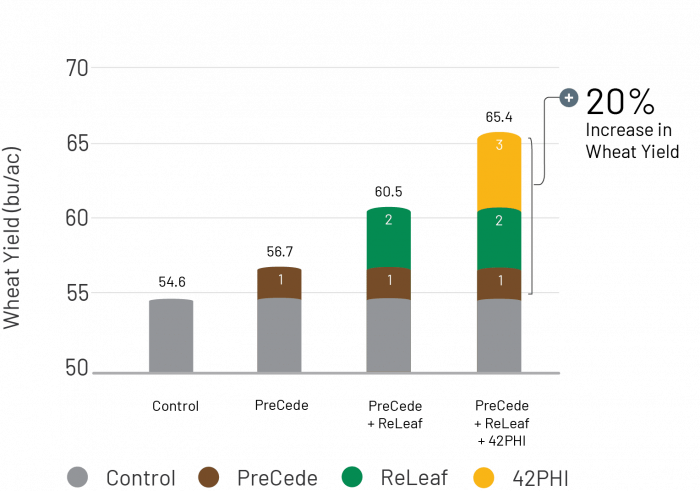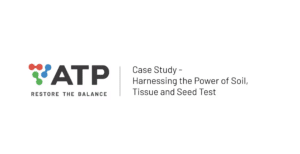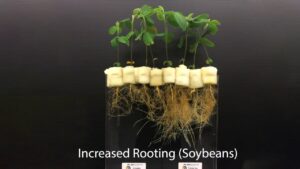
Cereal
Learn about the essential nutrients required by cereal crops throughout the growing season and how you can use plant nutrition and biostimulants to maximize the genetic potential of your cereal crop.
What are the nutritional requirements of a cereal crop?
Watch the video to learn about what nutrients are required by a cereal crop and the best times to apply them.
Essential nutrition for cereal crops
Essential nutrition for cereal can be divided into four key stages. Preventing a nutrient deficiency at each of these stages is crucial for preserving the genetic potential of the crop and maximizing yield potential. Use the tabs below to learn about the key nutrients required for each stage:
(Herbicide Timing)
(Fungicide Timing)

Seeds are naturally nutritionally imbalanced – adding a seed nutrient dressing with the following nutrients can help the seedling get off to a strong start.
- Phosphorus – energy production and photosynthesis
- Zinc – auxin production to drive rooting
- Manganese – photosynthesis (responsible for splitting the H2O molecule)
- Biostimulants (Transit S and Cellburst) can help drive rooting and enhance early seedling vigour, without having negative effects on the inoculant.
- The other key goal with adding biostimulants to the seed is to address and help overcome early season stresses, such as cold soils.

To address the needs of the seedlings (and limitations within the seed) it is vital to ensure the soil has the key nutrients properly placed (either seed placed or banded close to the seed) to drive rooting, photosynthesis and early season vigor
- Phosphorus – energy production and stimulates early season growth
- Zinc – auxin production to drive rooting
- Copper – assists in eliminating free radical buildup in the plants to optimize photosynthesis and rooting.
- Biostimulants (Synergro M2) – drive rooting and nutrient use efficiency
(Herbicide Timing)

During the vegetative growth stage, the crop is ramping up nutrient demand and energy production while still having a limited root system to acquire nutrients from the soil. The 3 to 5 leaf stage is the ideal timing to combine these critical nutrients with a herbicide application to meet the increased nutritional demand of the crop and optimizing each pass across the field:
- Phosphorus – energy production
- Potassium & Magnesium – critical for carbohydrate movement for yield production
- Zinc – root and shoot differentiation and moisture acquisition
- Manganese – optimize enzyme production and carbohydrate metabolism
- Copper – lignification of cell walls for standability and disease management
- Biostimulants (Transit-S and Cellburst) – abiotic stress management, root growth, & improving nutrient uptake and efficiency
(Fungicide Timing)

As the crop moves to the reproductive stage, there are key nutrients essential for pollination and fertilization. Ensuring these nutrients are present in adequate amounts prior to pollination is key:
- Phosphorus – hastens pant maturity and promote seed production
- Potassium – critical for carbohydrate movement
- Zinc – auxin production for pollen tube elongation
- Copper – stimulates nitrogen utilization and protein production along with proper lignification of reproductive plant parts
- Biostimulant (Cellburst) – pollen tube growth and elongation
During later season ripening, this is the stage where nutrition can impact the quality of the cereal crop. Applying these nutrients later in the season can have a positive impact on protein content.
- Nitrogen – drive protein production
- Zinc – better seed vigour and germination for next year’s crop
How much nutrition does your crop need?
Use our crop uptake and removal calculator to determine how much of each nutrient is required for your targeted yield.
System of Chemtrition

Developed in the lab and perfected in the field, the Chemtrition three-stage system works in tandem with your seed treatment, herbicide, and fungicide plan to deliver essential nutrients throughout the plant’s life cycle. Release the genetic potential of your crop through a proactive, balanced nutrient plan and get the most out of every acre.
Chemtrition = AgChem + Nutrition
PreCede
+ Seed Protectant
Rate: 3.0 L/MT Timing: Seed

- Drive lateral rooting with the optimal ratio of manganese and copper.
- Increase root development and eliminate carbohydrate root exudation with the addition of zinc.
- Enhance early season photosynthesis and overall plant health with the addition of phosphorus.
- Drive root development and address abiotic stress (cold soils) with the addition of key
- Synergistic impact to rooting when combined with seed protection products to improve overall plant health.
ReLeaf
+ Herbicide
Rate: 1.0 L/ac Timing: Foliar

- Enhance rooting and improve nutrient uptake with the addition of phosphorus.
- Manganese applied to balance phosphorus loading to drive rooting and photosynthesis.
- Increase lignin strength and photosynthetic efficiency with supplementary copper and zinc
- Drive sugar movement and proper cell wall integrity with potassium.
- Drive nutrient uptake and efficiency by the plant with key biostimulants
42PHI
+ Fungicide
Rate: 0.5-1.0 L/ac Timing: Foliar

- Enhance nutrient uptake and synergy with fungicides with the optimum load of phosphorus.
- Increase lignin strength and pollen viability with the addition of copper.
- Ensure the movement of carbohydrates and sugars to the reproductive parts of the plant by optimizing levels of potassium and magnesium
Proven Agronomic Performance
Field trials conducted in North America proved the synergistic effects of the System of Chemtrition in Wheat, showing an average increase of 20% in Wheat yield.

Achieving your Genetic Potential with Cereal
ATP’s cereal nutrition program helps you achieve the genetic potential of your crop – maximizing yield and quality. ATP’s comprehensive product portfolio provides you with a wide range of options to meet all your cereal nutritional requirements.
BBCH
TIMING

Seed Treatment

Soil

Herbicide

Fungicide
Micro-Che
Related Articles

Harnessing the Power of Soil, Tissue, and Seed Tests
Watch the Case Study video showing how one grower proactively used data on his crop

2025 Seed Testing Uncovers Widespread Nutrient Deficiencies
A recent analysis of 489 seed samples has revealed a concerning trend: 91% of the samples

The Importance of Seed Nutrition
The 2025 growing season is just around the corner! Seed nutrient dressings are a powerful,








